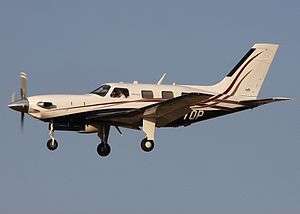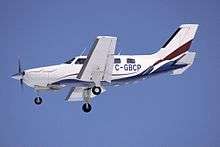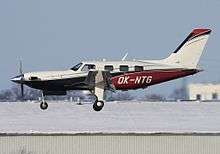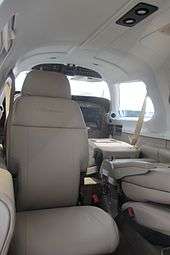Piper PA-46
| PA-46 Malibu | |
|---|---|
 | |
| PA-46-500TP Malibu Meridian | |
| Role | Light aircraft |
| National origin | United States |
| Manufacturer | Piper Aircraft |
| First flight | 30 November 1979 |
| Unit cost | |
The Piper PA-46 Malibu and Matrix are a family of American light aircraft manufactured by Piper Aircraft of Vero Beach, Florida. The aircraft is powered by a single engine and has the capacity for one pilot and five passengers. Early Malibus were all piston-engined, but a turboprop version, introduced as the Malibu Meridian but now called the M500, is also available.[2]
The PA-46 is the third single-engined piston aircraft with a pressurized cabin to reach the market, after the Mooney M22 and Cessna P210 Centurion, and the only one still in production.
Development
Work on the PA-46 began in the late 1970s, with a prototype (the PA-46-300T) first flying on November 30, 1979. The type was announced in November 1982, apparently to compete with Cessna's newest creation of the era, the P210 Centurion. Like the Centurion, the Malibu was to feature cabin pressurization (5.5 psi), a feature not included on the prototype.
Variants
PA-46-310P Malibu

The first example of the initial production version flew in August 1982, and FAA certification was obtained in September 1983. Deliveries started one month later. 404 aircraft with Continental TSIO-520 engines were built before this model was replaced in production by the PA-46-350P Malibu Mirage.
The PA-46-310P is powered by a Continental TSIO-520BE engine rated at 310 hp (230 kW). The PA-46-310P has lower fuel consumption, greater range, and the ability to cruise at "lean-of-peak." The PA-46-310P has a maximum cruising range of 1,550 nautical miles (with reserves), while the PA-46-350P initially had a maximum cruising range of only 1,055 nautical miles (1,954 km), although this is now increased to 1,345 nautical miles (2,491 km).[3]
The PA-46-310P Malibu has set several world speed records: Seattle to New York set November 23, 1987 at 259.27 mph (417 km/h); Detroit to Washington, DC set January 4, 1989 at 395.96 mph (637 km/h); and Chicago to Toronto set on January 8, 1989 at 439.13 mph (707 km/h). All three records were set by Steve Stout in his 1986 Malibu N9114B.[4]
The Continental TSIO-520-BE powered Malibu was discontinued in 1988 following a series of incidents and accidents attributed to engine failures. One such accident resulted in a settlement in which Teledyne Continental Motors paid $32,125,000 to a pilot injured in the crash of a Malibu.[5]
PA-46-350P Malibu Mirage
.jpg)
Production of the Malibu Mirage commenced in October 1988 for the 1989 model year. New features included a more powerful Lycoming TIO-540-AE2A 350 hp (260 kW) engine and a new wing. Various changes have occurred over the model years. Earlier models had an all-King panel and later this became largely Garmin, the Garmin G1000 glass cockpit is now standard.
In 1995, the pilot's windshield became a glass assembly (earlier it had been acrylic glass with a heat strip overlay). In 1996, numerous switches were moved to an overhead console. In 1999, the Mirage gained the strengthened wing designed for the turboprop Meridian.
PA-46-500TP Malibu Meridian

In 1997, Piper announced its intention to market a turboprop-powered version of the Malibu, and flew a prototype the following year powered by a Pratt & Whitney Canada PT6A-42A of 500 shp (370 kW). Certification was achieved in September 2000 and deliveries began in November that year. Changes made to allow for turboprop power include larger wings and tail surfaces. In 2009, Piper began offering the Meridian with a three-screen version of the Garmin G1000 including the Garmin GFC 700 autopilot as a replacement for the Avidyne Entegra system.
Piper M-Class
Piper Aircraft no longer refers to their top-of-the-line aircraft with the names Malibu, Malibu Mirage or Malibu Meridian. The PA-46 line of aircraft, as of 2015, is now referred to as the Piper M-Class. The M350, M500 and the newest M600, make up the entire M-Class line. The models range in price from the M350 at $1.15 million, to $2.26 million for the M500, to the flagship M600 whose pricing starts at over $2.8 million.[6]
M350
The M350 is an updated version of the Mirage. The M350 is fitted with the same 350 hp (261 kW) turbocharged Lycoming TIO-540-AE2A engine and Hartzell three-bladed propeller as the Mirage. Improvements over the Mirage are an Ametek digital fuel quantity system and an improved Garmin G1000 NXi flight system. The new Garmin system has envelope-protection and anti-hypoxia tools.[7] It will initiate an emergency descent in the case that the pilot becomes incapacitated as a result of hypoxia. The M350 is capable of cruising at 213 kn (394 km/h) with a range of 1,343 nmi (2,487 km). The plane has a service ceiling of 25,000 ft (7,620 m). No wind, standard day gross weight takeoff is achieved in 1,087 ft (331 m) and landing in 1,020 ft (311 m).[8][9]
M500
The M500 is an updated version of the Meridian. It also has the updated Garmin G1000 NXi flight system, like the M350. The G1000 NXi system includes an automatic wings-level function and control override to prevent exceeding the plane's flight envelope. Its purpose is to maintain a safe, stable flight condition in the case of pilot disorientation or incapacitation.[10] The safety feature is called Electronic Stability and Protection (ESP). The M500 also has ADS-B, but no FADEC. The M500's fuel tanks can carry 170 US gal (644 l) and its Pratt & Whitney PT6A-42A engine burns 37 US gal/h (140 l/h)[11]. It is a light plane with a maximum ramp weight of 5,135 lb (2,329 kg) and 5,092 lb (2,310 kg) MTOW. It cruises at 260 kn (482 km/h) at an altitude of 30,000 ft (9,144 m). The M500, at a price of $2.26M [12] has few competitors, including the cheaper sister-ship, Piper M350, the $2.3M Cirrus Vision SF50, the $3M Epic E1000 and the $3M Eclipse 550.[13]
M600
_(cropped).jpg)
In 2015, Piper introduced the M600, as an upgrade to the M500. The M600 has 600 hp (447 kW) and a price tag of $2.82 million. The new M600 is equipped with the Garmin G3000, a new wing and more fuel capacity. The aircraft is more capable than the M500, as the M600 has greater range and a slightly higher top speed.[14] It has anti-hypoxia tools like in the M350. [15]
It received its FAA certification on June 18, 2016. Its NBAA IFR range is 1,484 nmi (2,748 km), up from 1,000 nmi (1,852 km) for the M500, and max cruise speed is 274 kts up from the M500's 260 kts. The M600’s MTOW is 6,000 pounds, up from the M500’s 5,092 pounds, helping to accommodate a 260 gallons fuel capacity, greater than the M500's 170. The M600’s standard equipped weight is 200 pounds higher than the M500's. Full-fuel payload for the M600 is 645 pounds compared to 550 for the M500.[16]
Between June 2016 and March 2018, 50 have been delivered, mostly in the U.S. and mostly are owner-flown. It offers nearly the range of the TBM 900 for much less cost, and can operate from shorter runways than very light jets like the Eclipse 500 or the Citation Mustang. It burns 350 lb (160 kg) in the first hour, 300 lb (140 kg) the second hour and 200 lb (91 kg) thereafter, averaging 45 US gal (170 l) per hour, while $125–130 per hour have to be budgeted for the 1,800 h engine midlife inspection before the $150,000–200,000 3,600 h overhaul.[17]
PA-46R-350T Matrix
In October 2007 Piper announced the Matrix, an unpressurized version of the Mirage. The new model has been designated as the PA-46R-350T, indicating retractable landing gear, 350 horsepower (260 kW), and turbocharging.[18]
Piper Aircraft is marketing the Matrix as a cabin-class aircraft for Cirrus SR-22 and Cessna 400 owners to step up to.[18][19]
Standard equipment on the Matrix includes a built-in oxygen system, Avidyne Entegra glass cockpit, S-Tec 55X autopilot and air conditioning.[19]
Major options on the Matrix are a de-ice system, an "Enhanced Situational Awareness Package", speed brakes, an avionics package featuring the Avidyne TAS610 dual antenna traffic advisory system,[19] GWX-68 Weather Radar, and, beginning in 2010, the Garmin G1000 avionics system with twin 10" PFD's and a 15" MFD.
The Matrix's powerplant is a turbocharged Lycoming TI0-540-AE2A producing 350 hp (260 kW).[20] The aircraft's performance includes a cruise speed of 215 knots at 25,000 feet (7,600 m), 215 knots (398 km/h) at 17,500 feet (5,300 m) and 188 knots (348 km/h) at 12,000 feet (3,700 m).[19] Maximum takeoff weight is 4,340 lb (1,969 kg) and an empty weight of 2,937 lb (1,332 kg) giving a standard useful load of 1,421 lb (645 kg)).[20]
Matrix deliveries began in early 2008.[19]
JetPROP
The JetPROP DLX is an aftermarket turbine engine conversion for the PA-46-310P Malibu and PA-46-350P Malibu Mirage. Originally certified in August 1998 with a Pratt & Whitney PT6A-34, conversions 90 and above used the P&W PT6A-35 when the -34 was discontinued. A lower cost JetPROP DL conversion became available in October 2003 utilizing the P&W PT6A-21. As of September 2008, 233 JetPROP conversions had been completed and delivered by Rocket Engineering of Spokane, WA. Twenty percent of the entire PA-46 fleet have been converted.[21]
Production
| Model | 2002 | 2003 | 2004 | 2005 | 2006 | 2007 | 2008 | 2009 | 2010 | 2011 | 2012 | 2013 | 2014 | 2015 | 2016[23] | 2017[24] | Totals |
|---|---|---|---|---|---|---|---|---|---|---|---|---|---|---|---|---|---|
| M600 | – | – | - | – | – | – | – | – | – | – | – | – | – | – | 22 | 35 | 57 |
| M500/Malibu Meridian | 25 | 24 | 26 | 40 | 49 | 53 | 52 | 29 | 25 | 32 | 32 | 34 | 36 | 27 | 12 | 12 | 508 |
| M350/Malibu Mirage | 19 | 7 | 15 | 11 | 31 | 30 | 21 | 7 | 26 | 33 | 49 | 42 | 37 | 34 | 26 | 9 | 397 |
| Matrix | – | – | – | – | – | – | 101 | 33 | 23 | 17 | 12 | 16 | 11 | 2 | 0 | 0 | 215 |
| All | 44 | 31 | 41 | 51 | 80 | 83 | 174 | 69 | 74 | 82 | 93 | 92 | 84 | 63 | 60 | 56 | 1177 |
Specifications
.jpg)

| Model | Matrix[25] | M350[26] | M500[27] | M600[28] |
|---|---|---|---|---|
| Seating | 6 | |||
| Cabin Volume | 201 cu ft (5.7 m3) | |||
| Pressurization | 0 | 5.6 psi (0.39 bar) | ||
| Wingspan | 43.0 ft / 13.11 m | 43.16 ft / 13.15 m | ||
| Length | 28.11 ft / 8.6 m | 29.6 ft / 9.02 m | 29.7 ft / 9.05 m | |
| Height | 11.3 ft / 3.44 m | |||
| MTOW | 4,340 lb / 1,969 kg | 5,092 lb / 2,310 kg | 6,000 lb / 2,721 kg | |
| OEW | 3,003 lb / 1,362 kg | 3,050 lb / 1,383 kg | 3,436 lb / 1,559 kg | 3,650 lb / 1,656 kg |
| Fuel Capacity | 120 USgal / 454 L | 170 USgal / 644 L | 260 USgal / 984 L | |
| Constant-speed propeller | 3 blade | 4 blade feathering, reversible | ||
| Engine | Lycoming TIO-540-AE2A | Pratt & Whitney PT6A-42A | ||
| Power | 350 hp (260 kW) | 500 hp (370 kW) | 600 hp (450 kW) | |
| Maximum cruise | 213 kt / 395 km/h | 260 ktas / 482 km/h | 274 ktas / 507 km/h | |
| Ceiling | 25,000 ft / 7,620 m | 30,000 ft / 9,144 m | ||
| Range (45 minute reserve) | 1,343 nm / 2,487 km | 1,000 nm / 1,852 km | 1,484 nm / 2,668 km | |
| Takeoff (50 ft obstacle) | 2,090 ft / 637 m | 2,438 ft / 743 m | 2,635 ft / 803 m | |
| Landing (50 ft obstacle) | 1968 ft / 600 m | 2,110 ft / 643 m | 2,659 ft / 810 m | |
See also
Aircraft of comparable role, configuration and era
References
- Notes
- ↑ "Purchase Planning Handbook" (PDF). Business & Commercial Aviation. Aviation Week Network. May 2018.
- ↑ Federal Aviation Administration (October 2010). "Type Certificate Data Sheet No. A25SO" (PDF). Retrieved 14 March 2011.
- ↑ "Aircraft Information: Piper PA-46 Malibu/Malibu Mirage". Airliners.net.
- ↑ "Magazine" (PDF). Malibu/Mirage Owners & Pilots Association. May 1992. pp. 10–11.
- ↑ Paboojian v Teledyne Continental Motors, et al, Result: Settlement, $32,125,000
- ↑ "M600 Tops Piper Product Line". AOPA. Retrieved 24 February 2018.
- ↑ "Piper Launches Three New M-Class Models, Including a New Turboprop". avweb.com. Aviation Publishing Group. 13 April 2015. Retrieved 15 April 2015.
- ↑ "Specs & Performance – Piper". Piper.com. Retrieved September 20, 2015.
- ↑ "Piper Launches M600 and M350". Flyingmag.com. Retrieved September 20, 2015.
- ↑ "New Meridian: Piper updates pressurized turbine single". AOPA. January 27, 2015.
- ↑ Robert Goyer (6 April 2015). "We Fly: Piper Meridian M500". Flying.
- ↑ "Piper Launches Latest M500 Product With The Latest In Garmin Avionics". Piper. January 28, 2015.
- ↑ "Piper Meridian M500 Versus the World: Comparison Specs". Flying. April 10, 2015.
- ↑ Whitfield, Bethany (14 April 2015). "Piper Launches M600 and M350". Flying.
- ↑ "Video: Piper's New M600 Shows at Sun 'n Fun". avweb. April 21, 2015.
- ↑ Matt Thurber (June 20, 2016). "Piper M600 Receives FAA Certification". Aviation International News.
- ↑ Fred George (Mar 23, 2018). "Piper M600: Sweet Spot On The Price Vs. Performance Curve". Business & Commercial Aviation.
- 1 2 Robert Goyer: Piper Matrix Flying Magazine March 2008, page 56. Hachette Filipacchi Media USA Inc.
- 1 2 3 4 5 Flying Editors: Matrix: Cabin-Class Comfort for Less Flying Magazine January 2008, page 19. Hachette Filipacchi Media USA Inc.
- 1 2 Piper Aircraft (n.d.). "Matrix Price & Standard Equipment". Archived from the original on 2007-12-13. Retrieved 2007-12-13.
- ↑ JetPROP, LLC (2008). "About JetPROP". Archived from the original on 2008-10-11. Retrieved 2008-09-13.
- ↑ "General aviation statistical databook & 2016 industry outlook" (PDF). General aviation manufacturers association. 2016. Archived from the original (PDF) on 2016-08-07.
- ↑ "General Aviation Shipment Report 2016" (PDF). GAMA. Retrieved 24 February 2018.
- ↑ "General Aviation Shipment Report 2017" (PDF). GAMA. Retrieved 24 February 2018.
- ↑ "Matrix Specifications & performance". Piper.
- ↑ "M350 Specifications & performance". Piper.
- ↑ "M500 Specifications & performance". Piper.
- ↑ "M600 Specifications & performance". Piper.
External links
| Wikimedia Commons has media related to: |
- Matrix
- M350
- M500
- M600
- "The Piper Meridian". Aircraft Owners and Pilots Association. July 2012.
- James Wynbrandt (October 17, 2015). "Pilot Report: Piper PA-46 M500". Aviation International News.
- "FLIGHT TEST: Why top-of-the-range M600 is in tune with market demand". Flight Global. 5 September 2016.
- Fred George (August 25, 2016). "Flying Piper's New M600 Turboprop". Business & Commercial Aviation. Aviation Week.
- Matt Thurber (October 4, 2016). "Pilot Report: M600, Piper's Best Performer" (PDF). Aviation International News.